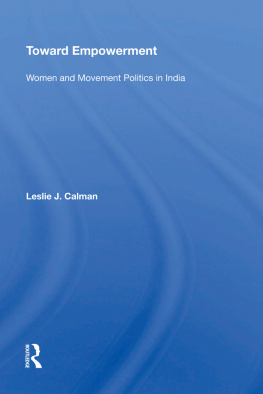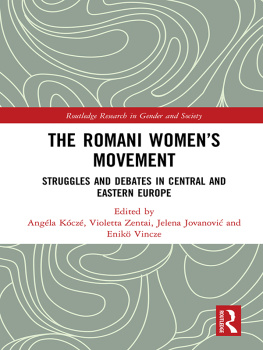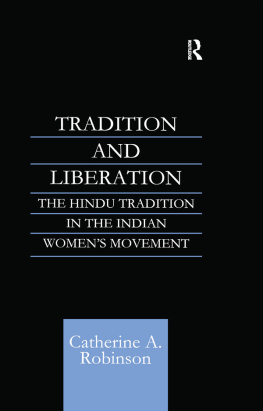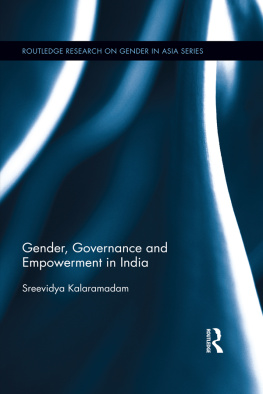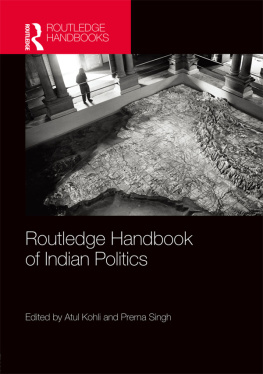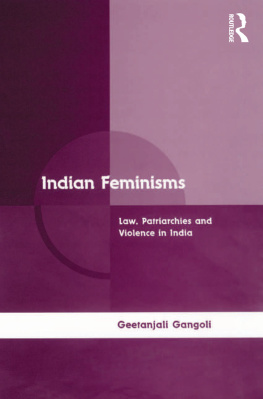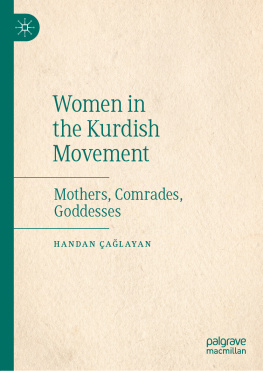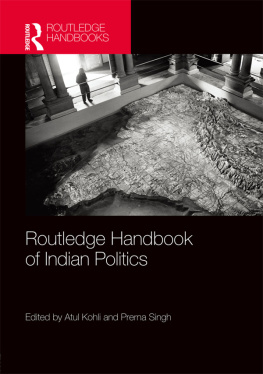Toward Empowerment
Toward Empowerment
Women and Movement Politics in India
Leslie J. Calman
BARNARD COLLEGE
First published 1992 by Westview Press
Published 2018 by Routledge
52 Vanderbilt Avenue, New York, NY 10017
2 Park Square, Milton Park, Abingdon, Oxon OX14 4RN
Routledge is an imprint of the Taylor & Francis Group, an informa business
Copyright 1992 by Taylor & Francis
Cover design incorporates a Warli tribal painting from Maharashtra
All rights reserved. No part of this book may be reprinted or reproduced or utilised in any form or by any electronic, mechanical, or other means, now known or hereafter invented, including photocopying and recording, or in any information storage or retrieval system, without permission in writing from the publishers.
Notice:
Product or corporate names may be trademarks or registered trademarks, and are used only for identification and explanation without intent to infringe.
Library of Congress Cataloging-in-Publication Data
Calman, Leslie J.
Toward empowerment: women and movement politics in India / Leslie
J. Calman.
p. cm.
Includes bibliographical references and index.
ISBN 0-8133-8103-7ISBN 0-8133-1695-2 (pbk.)
1. FeminismIndia. 2. Women in politicsIndia. 3. Women
IndiaSocial conditions.I. Title.
HQ1743.C35 1992
305.42'0954dc20 92-6420
CIP
ISBN 13: 978-0-367-21202-5 (hbk)
To Carole Christie
Contents
- PART ONE
Development of the Indian Women's Movement - PART TWO
Effectiveness and Potential
- PART ONE
Development of the Indian Women's Movement - PART TWO
Effectiveness and Potential
Guide
Although writing a book is in many respects a solitary enterprise, it can only be done with the help of a great many people. My debts in this instance are so extensive that I have divided them into two parts. The Preface contains thanks to many women in India whose work this study records. This section acknowledges those whose help was more monetary, editorial, and, not of least importance, personal.
The American Political Science Association and Barnard College provided the financial assistance that helped to make my fieldwork possible.
Demetrios Caraley and Rosalind Rosenberg cut, red-pencilled, and cajoled with the firmness of true and good friends. Many others read all or parts of the manuscript and helped, as much as I would let them, to whip it into final shape. My thanks go to Thomas Bernstein, Douglas Chalmers, Dennis Dalton, Neera Desai, Jana Everett, Martha Howell, Peter Juviler, Temma Kaplan, Mary F. Katzenstein, Morton Klass, jane Mansbridge, Vina Mazumdar, Hanna Papanek, Barnett Rubin, Kathleen Staudt, and Marcia Wright. My editor at Westview, Rebecca Ritke, has been an exacting and remarkably patient reader, and Amrita Basu and Manisha Desai generously shared valuable resources and thoughts.
Research and production were enhanced by the able and generous assistance of Goteh Nzidee, Valerie Green, Pat Karpen, Judith Aks, and Rachel Gibson. Paul Franklin baby-sat to perfection.
I am lucky indeed to enjoy the friendship of two families in India whose caring and generosity surpass even the warm hospitality for which India is rightly known. My thanks to Shukla, Kailash, Meenakshi, and Vinita Nath of New Delhi; and to Sonal, Haresh, and Kabir Shah of Bombay.
Finally, writing this book has meant far too many hours away from my loving family at home. Deepest thanks to Carole and to Benjamin for making it so difficult to leave and so very joyful to return.
Leslie J. Calman
This book documents the existence of a vital, dynamic women's movement in India. looks at the accomplishments and failings of the movement and seeks to project what promises and problems the future holds.
My decision to write a book on the women's movement in India grew out of my interests in political movements, India, and women in politics. Scholarly work on these topics has rarely overlapped in the past. Western theorists of movements focus largely on those in the United States and Europe, creating generalizations about movement politicsparticularly movement politics in democratic stateswith nary a glance at the developing world, including the world's largest democracy.
Through my examination of the Indian women's movement, I hope first, then, to inform movement theory. Particularly, I will explore the issue of what women in the developing world can hope to achieve through movement participation. Do women's movements serve valuable functions for women in the developing world that other, more traditional political institutions and processes do not? Social movement theory in the West has been long on the questions of why and how movements emerge, but short on the question of what movements accomplish; to the extent it has addressed the last question, it has done so in terms of advanced capitalist societies, not developing ones. I hope to help correct this imbalance.
The presence of political movements reveals something about the health and capacity of the political system in which they occur. When people choose to participate in movements, it may signify that other channels of political participation are closed to them. Or, it may mean that they face problems that are beyond the capacity of the state to solve, either because the state lacks commitment or resources, or because the problems lie in a social arena, such as the family, that is not wholly within the state's control. Thus, this examination of the causes of the emergence of the women's movement, and of how it has since fared in relation to the state, should reveal something of the capacities and limitations not only of this particular movement but of the Indian state as well.
Finally, I write also for those whose interest is in women in developing areas, and I think that the Indian case has much to teach. Scholars of women in developing areas have grown rightly wary of overgeneralizing about the problems and prospects of women in areas as vast and as distinct as the nations of Asia, Latin America, the Middle East, and Africa. Within the confines of the case study that follows, I have tried to be specific about which groups of Indian women are affected by and react to different social, economic, and political circumstances.
And yet, while it is necessary to be precise about the differences among women in developing areas, it is useful to note and explore their commonalities. Only in this way can the distinct experiences of one group of women illuminate pitfalls and promises for another. Commonalities among women in developing areas do exist in the conditions of day-to-day life. They are subject to violence by men (of their own families, or often, by unrelated men who hold economic power over them, such as landlords or moneylenders, or those with state power, like the police) that goes largely unpunished by the state.
Understanding how the Indian women's movement has attacked these problems, and with what degree of success, will help us to understand prospects elsewhere. All the circumstances described in the previous paragraph exist full-blown in India.
As of 1991, India had a population of some 850 million people. One struggles to understand the enormity of the figure. India's population is three and a third times that of the United States. It is 200 million greater than the continent of Africa's, 125 million greater than all of North and South America's, and 75 million greater than that of the United States, Canada, and Europe combined. Apart from China's 1.1 billion people, India contains 27 percent of the population of the entire third world. India is so vast, and its population so multifarious, that it is in some ways a world unto itself, worthy of study if only for the hundreds of millions it includes. However, it is more than that. Certainly, in many respects, it constitutes a microcosm of the problems of developing states; some of these problems are at their most severe in India.

